The USS Gerald R. Ford, the world’s largest warship and aircraft carrier, is over 1100 feet long and can carry more than 75 aircraft. It displaces around 100,000 tons. The carrier, owned by the United States, supports a crew of over 4500 personnel.
On 14th November the US Navy’s new aircraft carrier, USS Gerald R. Ford arrived in UK waters for her first visit to Europe. The 100,000-ton ship is the largest, most expensive and arguably the most powerful warship ever built. Here we report from onboard about her first operational deployment and now this vessel represents a step change in carrier aviation.
Transformational design
Although externally similar, the Ford-class aircraft carriers are not just an iterative development of the proceeding Nimitz class but a transformational design. 23 separate systems incorporating new technologies have been brought together to create a vessel that will ensure the US Navy maintains its already vast lead in carrier development over any of its global competitors. The decisions made by President George W. Bush and Defense Secretary Donald Rumsfeld to go for such a cutting-edge option came with enormous technical and financial risk which was perhaps underestimated at the time. The price tag for the vessel (not including aircraft) has risen to around $13.3bn with another $5bn spent on supporting research and development.
The new ship is the culmination of a twenty-year project, and although formally commissioned in July 2017, she did not achieve initial operating capability until December 2021. The first of class of any warship is also a prototype and many of its systems can only be fully tested when installed on the ship or at sea. Nearly 5 years were spent on fixing emerging issues with the new systems but as a project too big to fail, expenditure and hard work has finally paid off. The USN now has a platform that is by far the best on the planet, with a large margin of reserve space and power generation to absorb future ship and aircraft technologies. Broadly speaking the new design also enables Ford to generate higher sustained aircraft sortie rates, making for a safer, more survivable combat vessel with reduced crewing and maintenance requirements.
With a similar painful experience developing the Zumwalt class destroyers, the USN has subsequently said it will never again attempt to bring together so many new technologies together in one new warship design. Three further ships of the class are now under construction, the USS John F. Kennedy, USS Enterprise and USS Doris Miller, with a 5th planned. The Ford is the first new carrier design in 40 years and a statement of the USN’s continued commitment to tailhook aviation. Whether the USN will be able to maintain a balanced fleet while simultaneously replacing all 11 of its carriers on a one-for-one basis is open to debate. There are some that argue the USN should consider a smaller, affordable design to maintain numbers. The USN could probably build a CATOBAR carrier based on the Queen Elizabeth-Class design for around $4Bn.
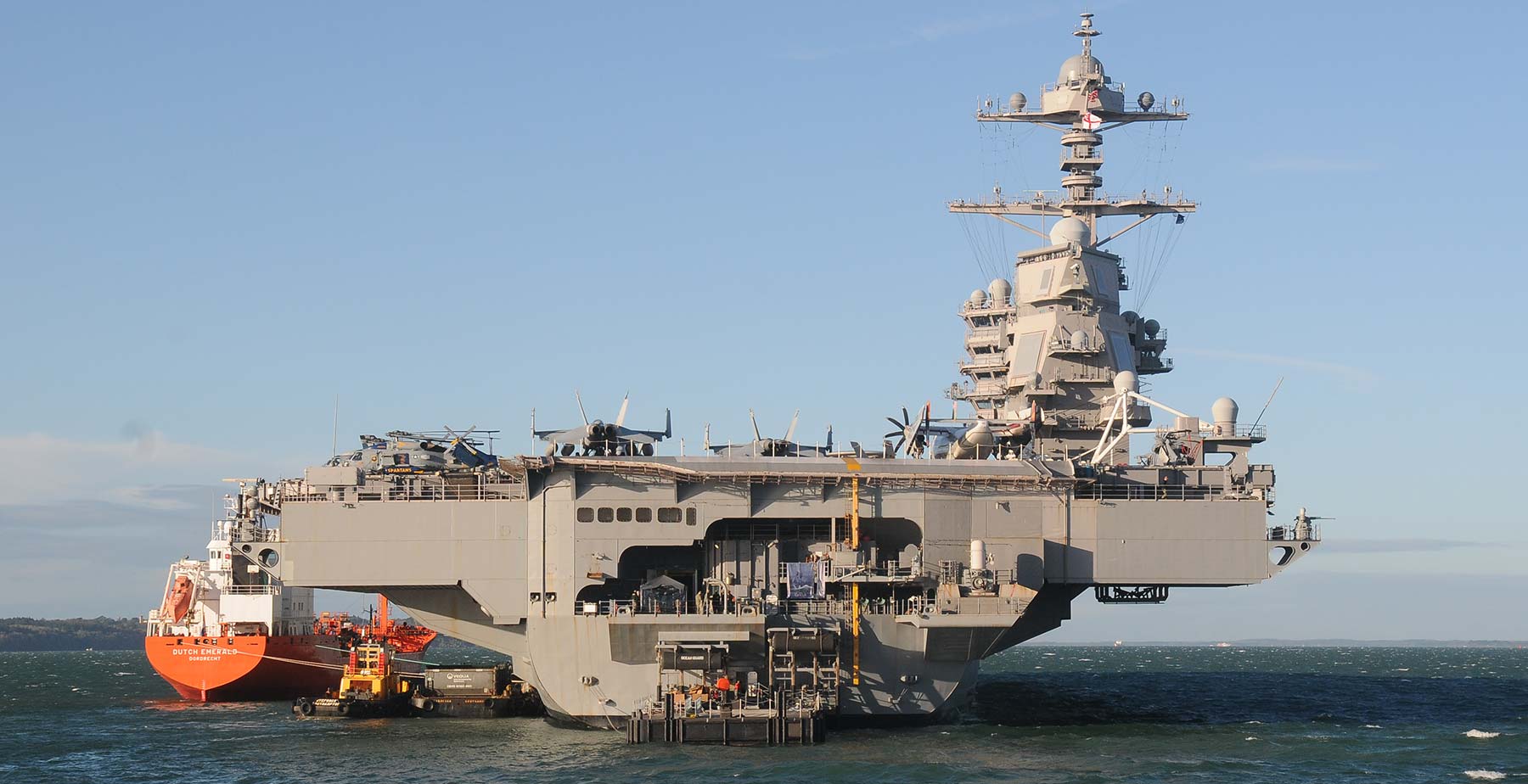
As with previous US aircraft carrier visits, the ship was on C-anchorage in Stokes Bay in the Solent. US Navy’s carriers are too large to pass through the narrow entrance to Portsmouth harbour. Liberty boats for the crew and for visitors secure to the pontoon at the stern (Photo: Navy Lookout).

The tanker MV Dutch Emerald alongside resupplying aviation fuel. (Photo: Navy Lookout)
Maiden deployment
The Ford sailed from Norfolk on the 4th October, the aim of the deployment is to test the ship in full carrier strike group operations and to test deep interoperability with NATO partners. She conducted her first overseas visit to Halifax in Canada before crossing the Atlantic in challenging weather conditions. Interviewed on board in the Solent, CO, Captain Paul Lanziolotta, said: “This ship is badass, a great system of systems, high technology is everywhere” but added that his crew have been working especially hard in the last year, still with a learning mindset about the new technology. He noted that the ship has generally performed well so far and by deploying further from the States for the first time, it offers a chance to test the logistic support for the new vessel.
A broadsheet journalist challenged the Captain about the threat to his ship from “cheap drones like we’ve seen in Ukraine” but Lanzilotta responded robustly: “One of the things about nuclear-powered warships, and this one in particular, is that manoeuvre is to our advantage. We’re not static. We tend to move the ship fairly aggressively and move large distances in small periods of time. I think that makes it pretty challenging for an inexpensive drone to be a challenge for me”.
Asked if she was “battle ready” the CO said: “There is a spectrum but we are at a high level of readiness, we are still working our way up to the very top level and have some workups still to do. If we were tasked to fight tomorrow we absolutely could”. The deployment represents a commitment to US allies and to maintain peace and stability in the European region. Commenting on his hosts he said: “The Royal Navy and Portsmouth command have really rolled out the red carpet for us and my sailors and I really appreciate that partnership and the welcome we’ve had here”.
The world’s largest warship USS Gerald R Ford on her maiden deployment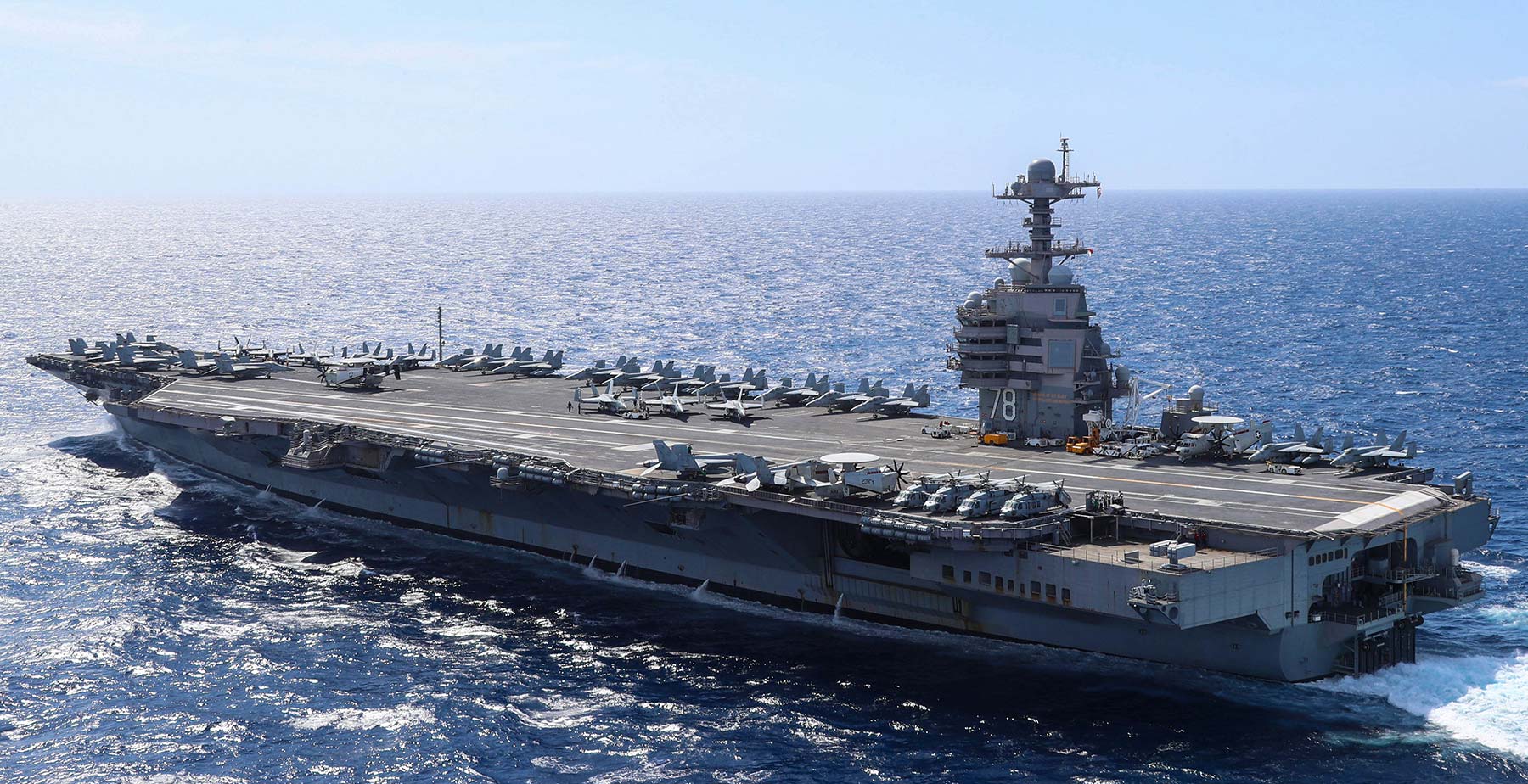
CVN-78 underway in the Atlantic during exercise Silent Wolverine 22 designed to test the first-in-class carrier with a strike group and integration with participating NATO allies which included ships from Spain, Denmark, Germany and the Netherlands. It was not confirmed or denied but exercises with the Royal Navy are likely to follow the visit to the UK. (Photos: US Navy)

The electric ship
Of the 23 new innovations, the main theme is the move towards electrification. The two nuclear reactors are of a new and more powerful design enabling the steam alternators to deliver almost 3 times the generation capacity of the Nimitz and a peak voltage of up to 13,800v. Besides providing energy for the majority of the ship’s systems, this leaves a large reserve to fit directed energy weapons or more powerful sensors in the future.
The most high-profile innovation has been the adoption of the Electro-Magnetic Aircraft Launch System (EMALS), replacing the steam-powered catapults pioneered by the Royal Navy in the 1950s. The main advantage of this system is reduced wear on the aircraft as launch power can be finely calculated. A typical steam cat launch provides 50 knots above what is actually required but the EMALS operator can select the exact thrust needed for the individual aircraft type, fuel/weapon load and wind conditions. This precision will be especially important in future, allowing the catapulting force to be reduced for smaller uncrewed aircraft types. The Captain, who launched from his ship in an E-2 Hawkeye aircraft recently, said EMALS “gives you a strong cat shot with no question in your mind you are going flying”. Assistant Air Officer, Cdr Richard Rosenbusch said that most aviators report that both catapulted take-off and arrested landings are slightly smoother on the Ford than the Nimitz class. EMALS also saves space, avoiding the need to pipe steam from the nuclear reactors as well as condensers and water purification plants.
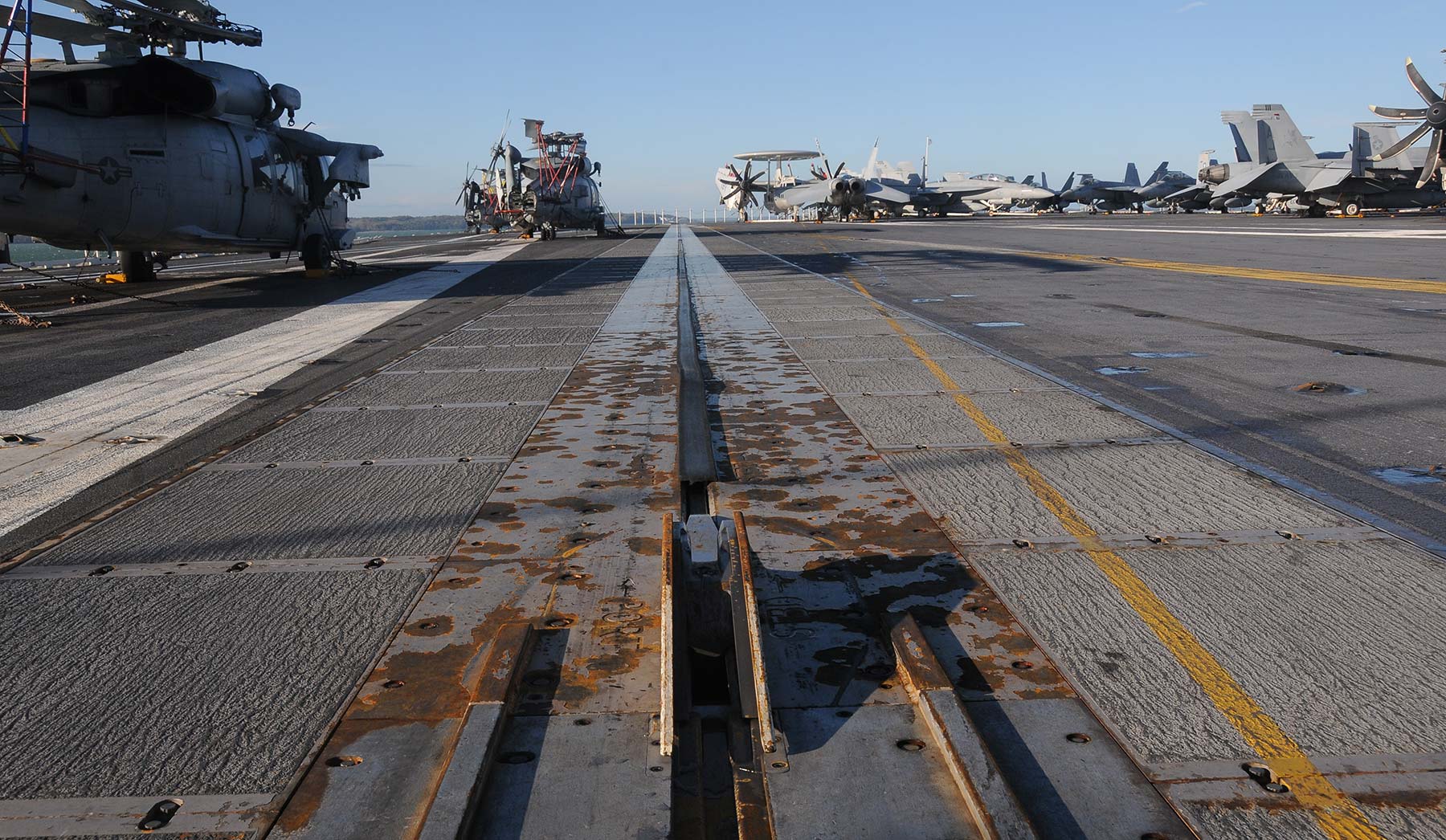
Seen from the flight deck, the EMALS system looks much the same as a steam catapult but below decks, the system is entirely different. The flight deck also has in-deck refuelling and electricity stations covered by small hatches, allowing the crews to plug aircraft straight in, avoiding the need for hoses or cables to be run across the deck to the catwalks at the edge. (Photo: Navy Lookout).
Maturing EMALS from a land-based demonstrator into a reliable ship-board system has proven to be a long and expensive process but the USN is now reaping the rewards. The Chinese are known to be developing EMALS for their carriers, although how far away from an operationally deployable system they may be is hard to say. General Atomics will supply two EMALS sets to the French for their future carrier (PANG) at a total cost of around $1.321 billion (including the arrestor gear). Those still advocating the QEC carriers are converted to full CATOBAR configuration should note the price tag.
The Advanced Arresting Gear (AAG) developed for the Ford allows the recovery of a greater range of aircraft and also reduces stress loadings on the airframe. The rotary engines comprise simple energy-absorbing water turbines coupled to an induction motor for fine control of the arresting forces. The two ends of the arrestor cables are attached to independent engines and computers rapidly calculate the tension to be applied to each in order to keep the aircraft centred and decelerating as smoothly as possible.

Advanced Weapons Elevator (AWE) with a weapon load in the centre. The vertical magnetic induction rails can be seen on each side (silver boxes) with the heavy blast doors in the raised position above. The lift is powered by its own batteries under the platform that are charged by induction saving on the need for cabling (Photo: US Navy).
AWE are another critical part of Ford’s new capabilities. The magazines and systems that bring munitions to the flight deck are a foundational part of aircraft carrier design and their importance is often overlooked. The Ford has eleven AWEs and issues with them were one of the long-running technical problems that delayed her entry into service. Cdr Jim Fish, the ship’s weapons officer said the lifts were now “working like a champ” and there had been no problems his technicians could not solve themselves on this deployment. The lifts are moved by electromagnetic induction without the need for hydraulics and cables. This greatly reduces maintenance and simplifies the design of heavy doors that seal off the elevator shafts between decks to make them blast, fire and flood proof.
The AWEs are rated for loads of 24,000lb ammunition and can travel at 150 ft per minute. Compared to the cable lifts of the Nimitz which are rated to 10,000 lbs and 100 feet per minute, this delivers a significant increase in sortie generation rate as aircraft can be armed faster and more safely. The Ford can sustain around 160 sorties per day compared with 140 for the Nimitz.
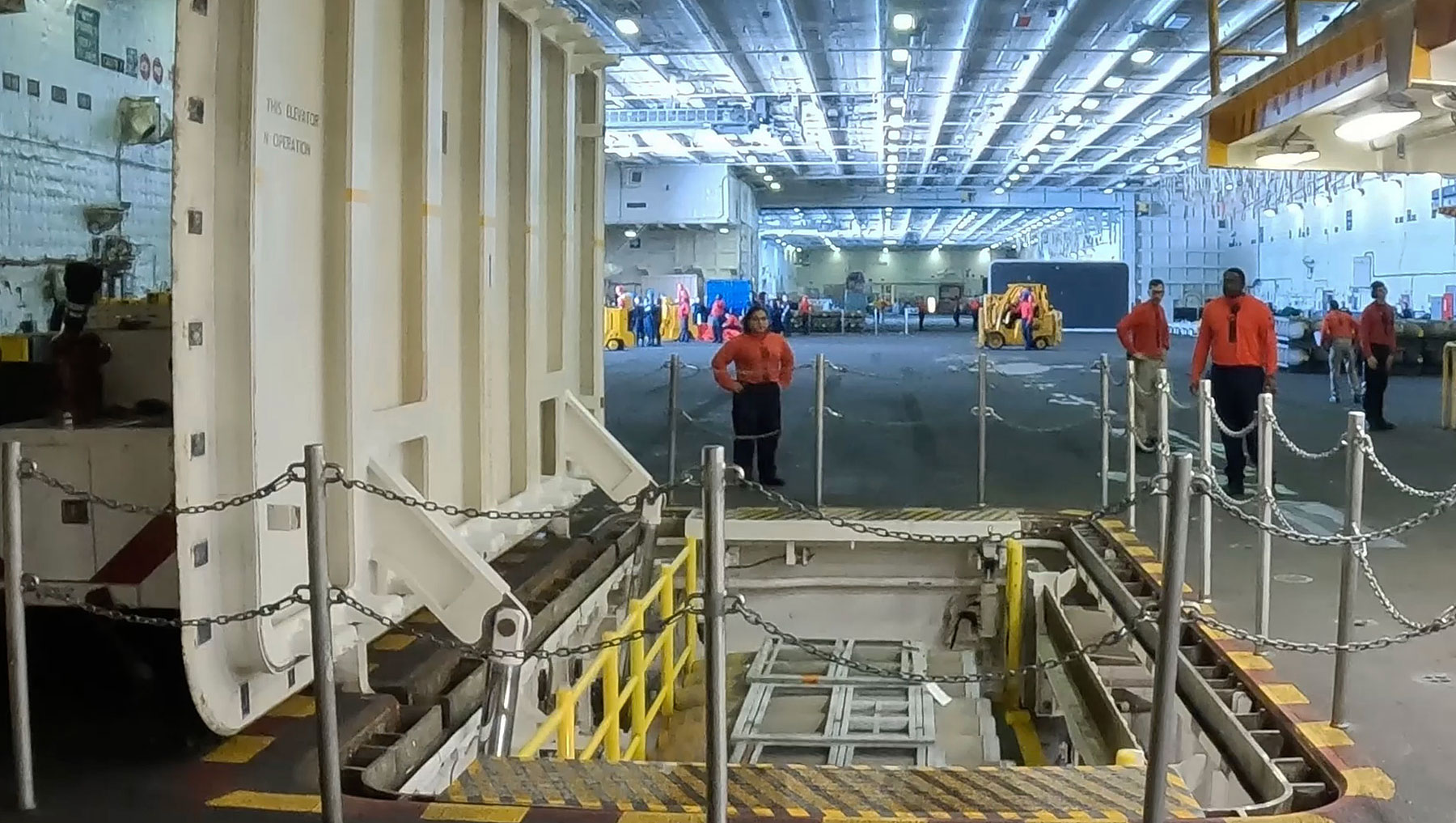
One of the lower stage lifts that emerges in the forward hangar bay (Photo: US Navy).
7 lower-stage AWEs bring weapons from the deep magazine up to the assembly areas and a further 4 small upper-stage AWEs bring ready weapons to the flight deck through hatches designed to fit under the wing of an aircraft when open. The Nimitz ammunition staging area is next to the island whereas all munitions are prepared under cover on the Ford which is much safer and frees up space for aircraft movements. Despite the major investment in the AWEs, ordnance on the Ford is still predominantly manually handled by personnel using transportation carts in the deep magazines. This philosophy is an interesting contrast to the automated systems of the QEC magazine that use a series of moles that move on rails to transport munitions loads from storage areas to the lifts. The USN has a much wider variety of ammunition types and does not suffer from the same manpower shortage as the RN.

The island is radically different to the Nimitz class and features a composite mast and the panels of the Dual Band Radar (DBR) which combines AESA radar X-band radar and S-band phased arrays derived from the Zumwalt destroyer programme. The Multi-Function Radar AN/SPY-3 is at the top and the volume search AN/SPY-4 radar is below. The Joint Precision Approach and Landing System (JPALS) antenna can be seen bottom right (Photo: Navy Lookout).
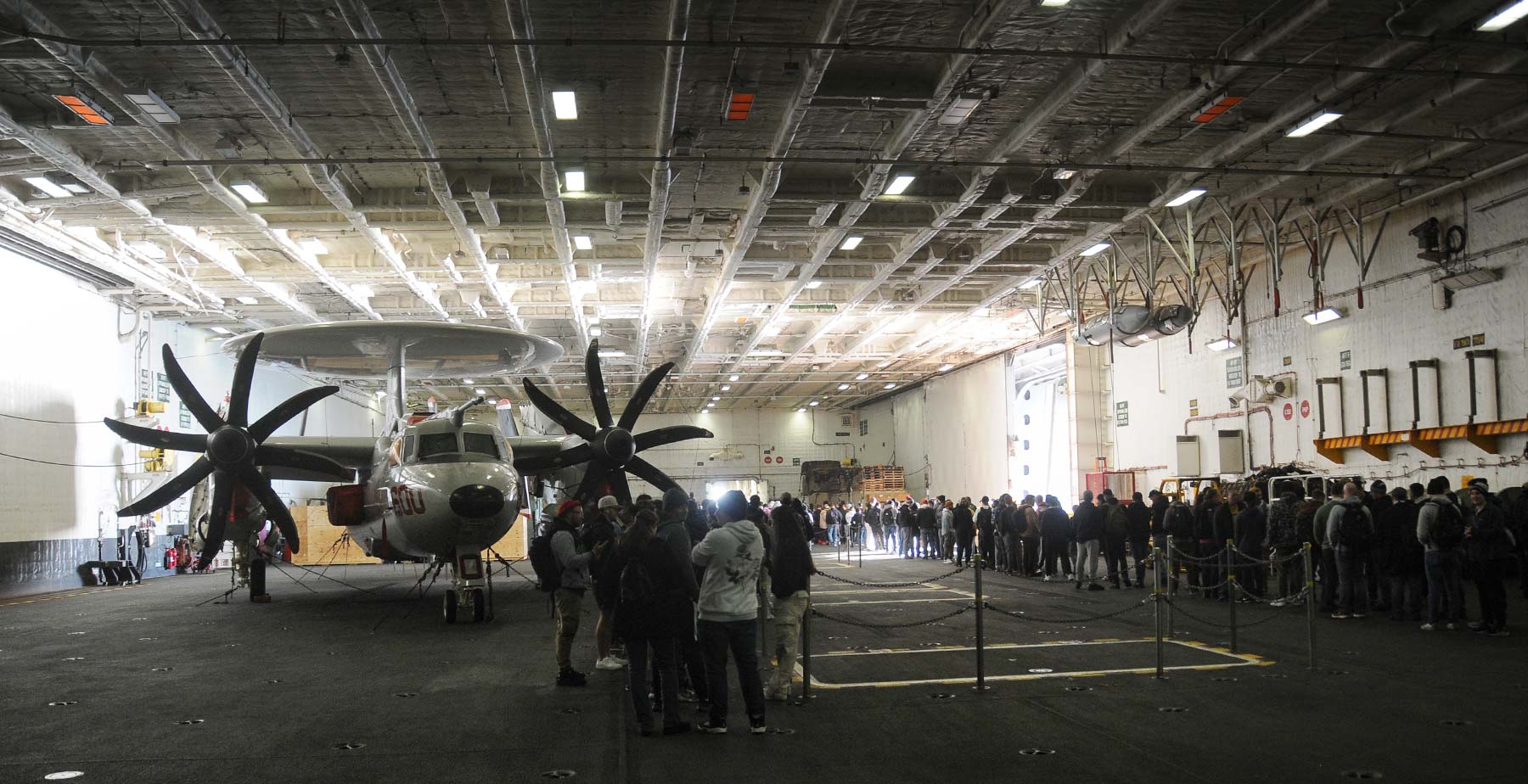
Sailors queue for the liberty boat to go ashore in the vast aft hangar. Ford has 2 large hangar bays – the Nimitz is divided into 3 bays but has similar capacity. (Photo: Navy Lookout).
There are some improvements to accommodation standards on the Ford and sailors reported the food was better than on other ships they had served on. However many junior enlisted personnel still sleep in 40-man berthing areas with 3-tier bunks and accommodation is noticeably more utilitarian than Royal Navy vessels. Junior rates on HMS Queen Elizabeth have twin bunks in 6-berth cabins and comfortable mess areas with carpet and soft furnishings.
Ford’s core ships company numbers around 2,600, a reduction of about 25% on the 3,500 required by the Nimitz. (The air wing adds another 2,400 people when embarked). The costs of sailors’ pay, benefits and pensions over their time in service are increasing and from a through-life perspective cost, the high initial outlay on automated systems may be justified. Just how resilient lean-manned warships like the QEC would be over a sustained period of combat operations or able to cope with a major damage control scenario is more debatable.

A long way from the bridge to the bow. About 60 aircraft of Carrier Air Wing 8 (CVW-8) have been embarked for this deployment but the carrier has capacity for up to around 75, depending on the aircraft types (Photo: Navy Lookout).

The F/A-18 E/F Super Hornet remains the backbone of US naval aviation. Surprisingly the Ford will not receive the modifications to operate F-35C until 2025. The US carriers based in the Pacific are being prioritised for F-35. The second Ford-class ship, CVN-79 will be delivered F-35-capable from the outset (Photo: Navy Lookout).
This article only skims the surface of the many engineering developments and capabilities of this mighty ship. For NATO nations, the sight of a US carrier is always reassuring as the ultimate power projection platform with combat aviation capability surpassing that of many entire air forces.

Farewell. Tug SD Tempest assists the Ford turning to head east down the Solent on 18th November. Part of a maritime ring of steel around Russia, along with HMS Queen Elizabeth, Ford is one of 5 allied carriers currently deployed on exercises or operations across the Euro-Atlantic region in a display of coordinated unity, strength and resolve by NATO (Photo: Chris Caine).